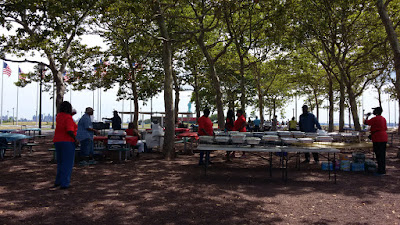This is our usual second exercise after chokutatsu. Renzoku means continuous. (read Chokutatsu first as I won't repeat much from that which applies here)
- Sensei yells "Renzoku Tsuke"
- Rei and take Kamae (this is sometimes yelled by the sensei and sometimes by the person that will receive first and sometimes not at all, may as well take any opportunity to yell I figure though)
- First receiver of each pair takes two smooth steps forward to Issoku
- Receiver makes a slight opening for the basic tsuke strike
- Receiver yells "Tsuzuite Tsuke"
- Attacker hits tsuke (suite) with a single step forward
- Attacker withdraws the strike (nuite) standing still but moving balance back to vertical
- At the same time as nuite the receiver takes a single large step back to issoku
- Attacker strikes and so it repeats. 3 strikes are made.
- After the last strike the receiver takes two large steps backwards
- The attacker does mai tsuke, a step to cover distance and a step to strike the fourth and final strike.
- Receiver takes two small steps back to issoku and the gun shake signal of role reversal is done
- Entire process is repeated with roles reversed
Important Points:
- The timing of the nuite and receiver stepping back should be nicely synchronised and smooth. Do not use footwork which would result in bouncing your centre of gravity up and down. Especially on the last double step.
- The final strike for the attacker should be a single movement, it may be two steps but there is no stopping in between them.
- Also ensure that your momentum doesn't make the last strike have a pushing aspect to it. It should be just as distinctive as the one step cuts.
- To get the final two steps smoothly don't focus on your front foot stepping out. It moves out sure but that is just to get your centre of gravity where your back foot can come in and then push hard.






